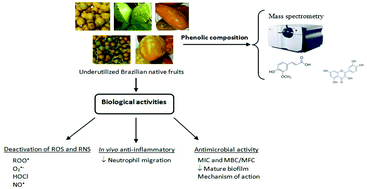Phenolic profile and potential beneficial effects of underutilized Brazilian native fruits on scavenging of ROS and RNS and anti-inflammatory and antimicrobial properties
Abstract
Brazilian native fruits (BNF) have aroused interest of researchers and consumers for their great human health benefits. In this study, five BNF (Byrsonima lancifolia, Campomanesia phaea, Jacaratia spinosa, Solanum alternatopinnatum and Acnistus arborescens) were tested for their polyphenolic compounds by LC-ESI-MS/MS, reactive species deactivation (ROO˙, O2˙−, HOCl and NO˙), anti-inflammatory properties in vivo, and in vitro antimicrobial activity – with determination of putative mechanism(s) of action. Eighty-one polyphenols were identified, which exhibited a significant capacity to deactivate both ROS and RNS. C. phaea extract had the highest capacity to scavenge ROO˙ (68.94 μmol TE per g), O2˙− (IC50: 575.36 μg mL−1) and NO˙ (IC50: 16.96 μg mL−1), which may be attributed to the presence of ellagitanins. B. lancifolia decreased neutrophil influx into the peritoneal cavity of mice by 50% as compared to carrageenan and reduced Candida albicans biofilm viability by 3 log10 possibly due to complexation with cell membrane ergosterol. In summary, the BNF presented herein are good sources of bioactive compounds with positive effects on deactivation of biological reactive species, as well as with anti-inflammatory and antimicrobial activities, which can be altogether highly beneficial to human health.



 Please wait while we load your content...
Please wait while we load your content...